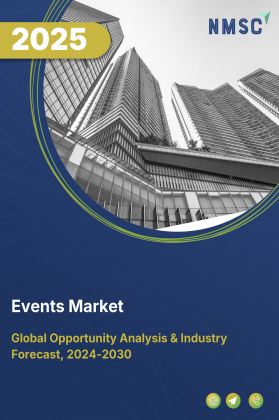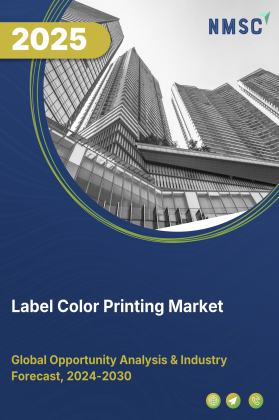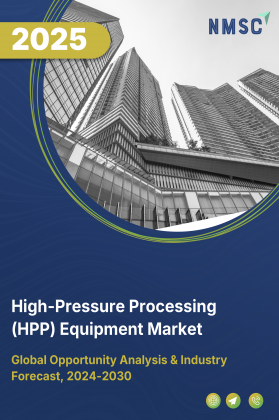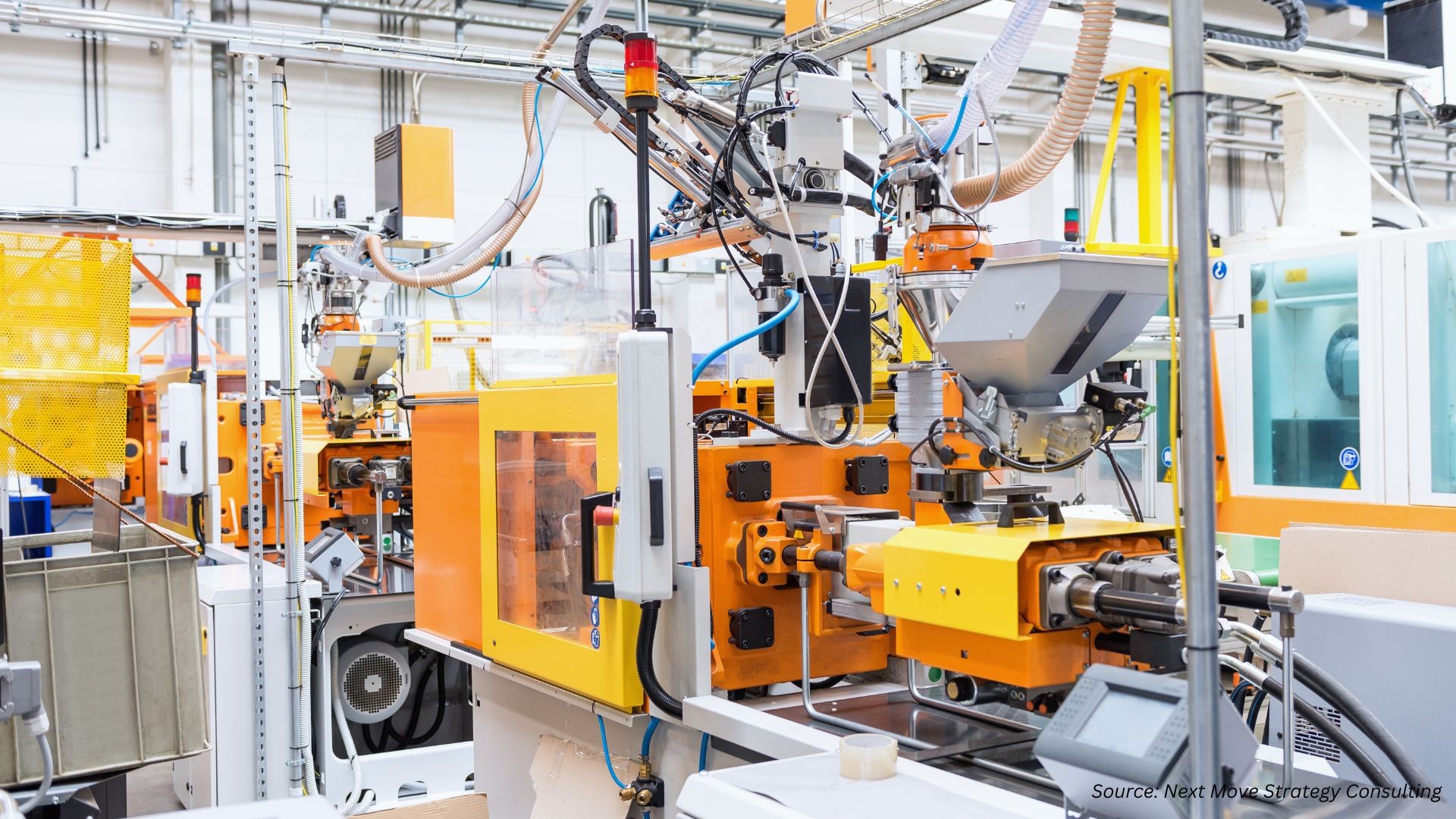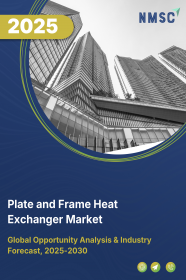
Plate and Frame Heat Exchanger Market by Product Type, (Gasketed, Brazed, Welded, Other, by Material Type, Stainless Steel, Titanium, Nickel Alloys, Non-Metallic), by Technology, (Standard PFHEs, Smart-Enabled PFHEs, by Heating/Cooling Process, Gas-to-Gas, Liquid-to-Gas, Liquid-to-Liquid), by Operating Temperature Range, (Low (0–40 °C), Medium (41–120 °C), High (>120 °C)), by Operating Pressure, (Low (<20 bar), and others)– Global Opportunity Analysis and Industry Forecast 2025-2030
Market Definition
Plate and Frame Heat Exchanger Industry Overview
The global Plate and Frame Heat Exchanger Market size was valued at USD 6.31 billion in 2024 and is predicted to reach USD 6.70 billion by the end of 2025. The industry is predicted to reach USD 9.05 billion by 2030 with a CAGR of 6.2% from 2025 to 2030.
The plate and frame heat exchangers market are gaining traction as industries prioritize energy efficiency, regulatory compliance, and sustainable operations. With rising energy costs and tightening environmental standards, these heat exchangers are becoming essential in applications requiring high thermal performance and reduced energy consumption. Their modular and compact designs not only support efficient heat transfer but also align with modern sustainability goals. While high initial investment remains a challenge, the long-term benefits in operational efficiency and adaptability are driving adoption across sectors such as power generation, chemical processing, and HVAC. As demand continues to shift toward eco-friendly and scalable solutions, the market presents significant opportunities for innovation and growth.
Energy Efficiency and Sustainable Design Drives the Plate and Frame Heat Exchanger Market Growth
As industries worldwide face rising energy costs and environmental concerns, the demand for energy-efficient systems has surged. Compact heat exchangers, known for their superior heat transfer efficiency, offer a sustainable solution to reduce energy consumption. For instance, Alfa Laval’s innovative designs, which optimize energy use in HVAC systems, have contributed to the widespread adoption of heat exchangers in various energy-intensive industries.
With the growing complexity of industrial processes, the demand for high-performance heat exchangers that can handle diverse and extreme operating conditions is increasing. Plate and frame heat exchangers are capable of delivering superior thermal performance under a wide range of temperatures and pressures, making them ideal for industries such as power generation and chemical processing, where high-efficiency heat exchange is critical.
A key example is Kelvion’s 2024 introduction of the NX100M plate heat exchanger, engineered to meet rigorous demands in power and process applications. The model features optimized plate geometry for improved heat transfer and compact design, addressing industry needs for efficiency, space savings, and robust performance under high-stress conditions.
Regulatory Pressure for Efficiency Standards Drives the Market Growth
Increasing environmental regulations globally are pushing industries toward adopting more energy-efficient technologies. Governments and regulatory bodies are setting higher standards for heat transfer efficiency, which is directly benefiting the plate and frame heat exchanger market demand.
For example, stringent emission norms in the European Union are prompting manufacturers to upgrade their systems to comply with these regulations, further driving the market. A notable instance is Alfa Laval’s 2023 launch of the TS45 plate heat exchanger, which is designed for high-efficiency thermal transfer with reduced energy consumption. This product supports industries in meeting stricter EU environmental standards while improving operational sustainability.
High Initial Investment Costs Hinder Market Expansion
The high upfront costs associated with purchasing and installing brazed plate heat exchanger remain a significant barrier, particularly for SMEs. The cost of the units themselves, combined with the expenses of integration with existing systems and employee training, can be prohibitive for smaller businesses. While the long-term energy savings offer ROI, the initial investment required is a challenge, especially in industries with narrow profit margins.
Modular Designs Plate and Frame Heat Exchangers Create Opportunity for Market Growth
A promising opportunity lies in the growing demand for sustainable and modular heat exchanger designs. As industries focus on reducing their carbon footprint, plate and frame heat exchangers that can be easily modified or retrofitted to existing systems are highly sought after. Companies that offer adaptable and eco-friendly solutions, such as the innovations seen from manufacturers like Tranter and Alfa Laval, stand to gain from this demand for flexibility and sustainability in industrial operations.
One of the latest innovations in this space is Alfa Laval’s launch of the "Unique Heat Exchanger" series in 2024, which features a modular design that can be quickly adjusted to accommodate changing process conditions. This new system emphasizes energy efficiency and sustainability, reducing both operating costs and environmental impact. The launch of this product reflects a broader industry shift toward solutions that not only optimize heat exchange processes but also align with global sustainability goals. Such advancements make Alfa Laval a key player in the growing trend toward sustainable and modular heat exchangers.
The plate and frame heat exchanger market report is segmented based on product type, service, heating process, operating temperature range, end user, and region. On the basis of product type, the market is divided into gasketed plate and frame heat exchangers, welded plate and frame heat exchangers, brazed plate and frame heat exchangers, and others. Welded plate and frame heat exchangers is further divided into welded plate and block, welded spiral, and welded shell and plate. On the basis of service, the market is segmented into inspection, cleaning, repair and maintenance, and others. On the basis of heating process, the market is classified into gas to gas, liquid to gas, and liquid to liquid. On the basis of operating temperature range, the market is divided into 0 to 40ºC, 41 to 120ºC, and above 120ºC. On the basis of end user, the market is segmented into residential, commercial, and industrial. Industrial is further divided into chemical, petrochemical and oil and gas, HVAC and refrigeration, food and beverage, power generation, pulp and paper, and others. On the basis of region, the market is analyzed across North America, Europe, Asia Pacific, and Rest of the World.
North America's plate and frame heat exchangers market share is experiencing steady growth, driven by the region's strong emphasis on energy efficiency and environmental compliance. With tightening emissions standards from regulatory bodies such as the U.S. Environmental Protection Agency, which notes that advanced heat exchangers can reduce HVAC energy usage by up to 50%, industries across sectors, especially HVAC, oil & gas, and food processing, are upgrading to more sustainable heat exchange solutions. The retrofit market is particularly active, as facility owners prefer modernizing existing systems over capital-intensive replacements, supported by the U.S. Department of Energy's projection that efficient energy technologies save firms up to 30% on power costs. Leading manufacturers such as SPX FLOW and Xylem continue to expand their market share through innovative, compact designs optimized for American industrial demands.
Europe represents a mature yet dynamic market for plate and frame heat exchangers, bolstered by stringent environmental regulations and aggressive decarbonization goals under the European Green Deal, which targets a 20% improvement in energy efficiency by 2030. Countries like Germany, France, and the Nordics are leading adoption, especially in district heating, renewable energy, and industrial processing, with the European Environmental Agency reporting that F-gas emissions regulations have driven heat exchanger adoption to curb emissions. Companies such as Alfa Laval and Kelvion are investing heavily in R&D to develop heat exchangers that meet the EU's rigorous energy performance standards. The region’s focus on circular economy principles and carbon neutrality is significantly influencing market trends and shaping long-term growth potential.
Asia-Pacific holds the largest growth potential in the global plate and frame heat exchangers industry, fueled by rapid industrialization, urbanization, and infrastructure development. Countries like China, India, Japan, and South Korea are witnessing strong demand across power generation, petrochemical, and food & beverage sectors, with China's 14th Five-Year Plan emphasizing green technologies to boost heat exchanger adoption. The Japanese Ministry of Economy, Trade and Industry reports a 8.7% increase in crude oil imports in 2023, driving demand for heat exchangers in refining. With rising energy consumption and government-backed clean energy initiatives, the region is prioritizing efficient thermal management systems. Local manufacturers are scaling up production, while global players such as Tranter and Danfoss are expanding regional operations to capture market share in this high-growth landscape.
In regions grouped under the Rest of the World, comprising Latin America, the Middle East, and Africa, the plate and frame heat exchangers market is gradually gaining traction. Growth is largely supported by infrastructure upgrades, water treatment projects, and climate-adaptive industrial systems. Brazil and South Africa are investing in energy-efficient technologies for manufacturing, while GCC countries in the Middle East are integrating high-performance heat exchangers into their desalination and oil refining operations. Although the industry size is smaller compared to other regions, the rising focus on sustainable and cost-effective thermal systems signals strong future potential.
Strategic Innovation in Plate and Frame Heat Exchanger Market
Key players in the global plate and frame heat exchangers industry are focusing on strategies that combine innovation, sustainability, and scalability to meet changing industry needs and strengthen their market position. Companies such as Alfa Laval, Tranter, Kelvion, and Danfoss are investing in modular and energy-efficient heat exchangers to address strict environmental regulations and the growing demand for compact and reliable thermal systems. For example, Alfa Laval has introduced advanced gasketed plate heat exchangers designed for HVAC and food industries, offering easy maintenance and lower long-term costs. Similarly, Tranter has launched retrofit-friendly models suited for industries with space and integration challenges, supporting the broader shift toward flexible and efficient operations.
Despite these efforts, manufacturers still face key challenges. High upfront investment, material cost fluctuations, and ongoing supply chain issues continue to affect adoption, especially for small and mid-sized companies. Technical hurdles such as customization and system compatibility also limit broader use in some sectors.
The market holds strong growth potential, with new opportunities emerging through industrial automation, the shift to low-carbon energy systems, and the integration of digital twin technology. These advancements are enabling predictive maintenance and real-time performance monitoring, helping users reduce downtime and optimize energy efficiency.
For instance, Danfoss has started equipping its plate heat exchangers with IoT-enabled features that provide live operational insights. As industries continue prioritizing sustainability and smart manufacturing, companies that align their offerings with eco-friendly and tech-driven solutions will be well-positioned to lead future expansion in the global plate and frame heat exchangers industry.
Key Benefits
-
The report provides quantitative analysis and estimations of the market from 2025 to 2030, which assists in identifying the prevailing market opportunities.
-
The study comprises a deep dive analysis of the market including the current and future trends to depict prevalent investment pockets in the market.
-
Information related to key drivers, restraints, and opportunities and their impact on the market is provided in the report.
-
Competitive analysis of the players, along with their market share is provided in the report.
-
SWOT analysis and Porters Five Forces model is elaborated in the study.
-
Value chain analysis in the market study provides a clear picture of roles of stakeholders.
Plate And Frame Heat Exchanger Market Key Segments
By Product Type
-
Gasketed
-
Brazed
-
Welded
-
Welded Plate And Block
-
Welded Spiral
-
Welded Shell And Plate
-
-
Other
-
Semi-welded
-
Fusion-bonded
-
Compact/hybrid
-
By Material Type
-
Stainless Steel
-
Titanium
-
Nickel Alloys
-
Non-metallic
By Technology
-
Standard Pfhes
-
Smart-enabled Pfhes
By Heating/cooling Process
-
Gas-to-gas
-
Liquid-to-gas
-
Liquid-to-liquid
By Operating Temperature Range
-
Low (0–40 °c)
-
Medium (41–120 °c)
-
High (>120 °c)
By Operating Pressure
-
Low (<20 Bar)
-
Medium (20–70 Bar)
-
High (>70 Bar)
By Application / End Use
-
Residential
-
Commercial
-
Industrial
-
Hvac And Refrigeration
-
Food And Beverage
-
Chemical And Petrochemical
-
Oil And Gas
-
Power Generation
-
Pulp And Paper
-
Industrial Manufacturing
-
Others
-
By Distribution Channel
-
Direct Sales (oem)
-
Distributors/partners
-
E-commerce
By Revenue Source
-
New Equipment Sales
-
After-sales Services
By Region
-
North America
-
The U.S.
-
Canada
-
Mexico
-
-
Europe
-
The UK
-
Germany
-
France
-
Italy
-
Spain
-
Denmark
-
Netherlands
-
Finland
-
Sweden
-
Norway
-
Russia
-
Rest of Europe
-
-
Asia Pacific
-
China
-
Japan
-
India
-
South Korea
-
Australia
-
Indonesia
-
Singapore
-
Taiwan
-
Thailand
-
Rest of Asia Pacific
-
-
RoW
-
Latin America
-
Middle East
-
Africa
-
Key Players
-
Alfa Laval AB
-
Danfoss A/S
-
Kelvion Holding GmbH
-
SPX Flow, Inc.
-
Xylem Inc.
-
API Heat Transfer Inc.
-
H. Guntner GmbH And Co. KG
-
Funke Warmeaustauscher GmbH
-
SWEP International AB
-
Johnson Controls International Plc
-
Wabtec Corporation
-
Boyd Corporation
-
Hisaka Works, Ltd.
-
Fischer Maschinen-und Apparatebau GmbH
-
HRS Heat Exchangers Ltd.
-
Sondex Group
-
Modine Manufacturing Company
-
Radiant Heat Exchangers Pvt Ltd
-
Barriquand Technologies Thermiques
-
KAORI Heat Treatment Co., Ltd.
Report Scope and Segmentation
|
Parameters |
Details |
|
Market Size in 2024 |
USD 6.31 billion |
|
Revenue Forecast in 2030 |
USD 9.05 billion |
|
Growth Rate |
CAGR of 6.2% from 2025 to 2030 |
|
Analysis Period |
2024–2030 |
|
Base Year Considered |
2024 |
|
Forecast Period |
2025–2030 |
|
Market Size Estimation |
Billion (USD) |
|
Growth Factors |
|
|
Countries Covered |
28 |
|
Companies Profiled |
20 |
|
Market Share |
Available for 10 companies |
|
Customization Scope |
Free customization (equivalent up to 80 working hours of analysts) after purchase. Addition or alteration to country, regional, and segment scope. |
|
Pricing and Purchase Options |
Avail customized purchase options to meet your exact research needs. |

















 Speak to Our Analyst
Speak to Our Analyst



